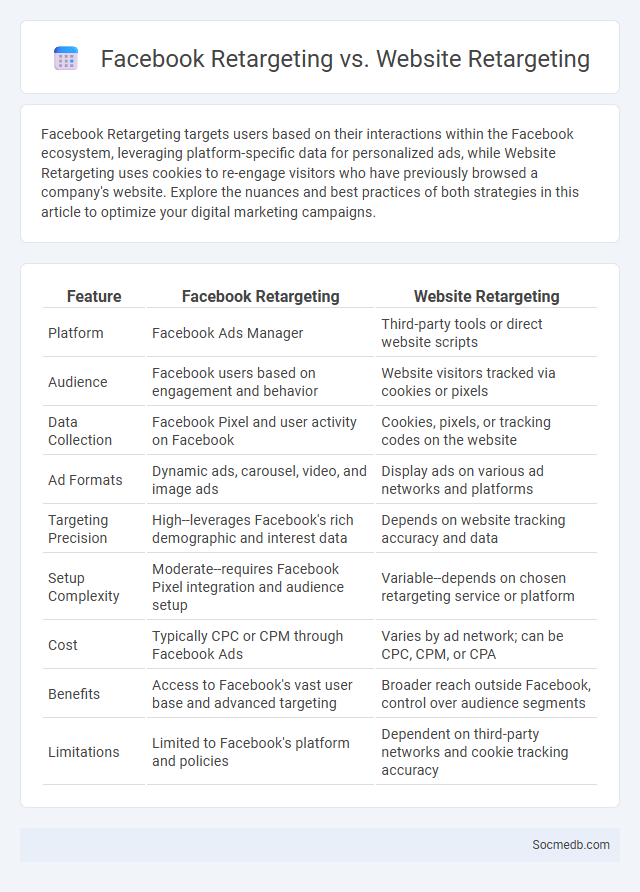
Photo illustration: Facebook Retargeting vs Website Retargeting
Facebook Retargeting targets users based on their interactions within the Facebook ecosystem, leveraging platform-specific data for personalized ads, while Website Retargeting uses cookies to re-engage visitors who have previously browsed a company's website. Explore the nuances and best practices of both strategies in this article to optimize your digital marketing campaigns.
Table of Comparison
| Feature | Facebook Retargeting | Website Retargeting |
|---|---|---|
| Platform | Facebook Ads Manager | Third-party tools or direct website scripts |
| Audience | Facebook users based on engagement and behavior | Website visitors tracked via cookies or pixels |
| Data Collection | Facebook Pixel and user activity on Facebook | Cookies, pixels, or tracking codes on the website |
| Ad Formats | Dynamic ads, carousel, video, and image ads | Display ads on various ad networks and platforms |
| Targeting Precision | High--leverages Facebook's rich demographic and interest data | Depends on website tracking accuracy and data |
| Setup Complexity | Moderate--requires Facebook Pixel integration and audience setup | Variable--depends on chosen retargeting service or platform |
| Cost | Typically CPC or CPM through Facebook Ads | Varies by ad network; can be CPC, CPM, or CPA |
| Benefits | Access to Facebook's vast user base and advanced targeting | Broader reach outside Facebook, control over audience segments |
| Limitations | Limited to Facebook's platform and policies | Dependent on third-party networks and cookie tracking accuracy |
Introduction to Retargeting: Concepts and Importance
Retargeting is a strategic digital marketing technique that targets users who have previously interacted with a brand's website or social media content but did not convert. This approach leverages cookies and tracking pixels to deliver personalized ads, increasing the likelihood of user engagement and conversion. Understanding the importance of retargeting lies in its ability to enhance brand recall, improve return on ad spend (ROAS), and drive higher conversion rates in social media advertising campaigns.
What is Facebook Retargeting?
Facebook Retargeting is a digital marketing strategy that targets users who have previously interacted with a brand's website or content on Facebook. By using tracking pixels and cookies, businesses can show customized ads to potential customers, increasing conversion rates and boosting return on ad spend (ROAS). This technique leverages user behavior data to re-engage visitors, driving higher engagement and sales through personalized ad experiences.
Facebook Retargeting: Key Benefits
Facebook retargeting enhances conversion rates by targeting users who have previously interacted with your content, increasing the likelihood of completing a purchase. It improves ad relevance through personalized messaging based on user behavior, resulting in higher engagement and lower cost-per-click. Leveraging Facebook's extensive data and advanced algorithms ensures precise audience segmentation, maximizing return on ad spend and overall campaign efficiency.
Understanding Website Retargeting
Website retargeting leverages social media platforms to reconnect with users who visited your site but didn't convert, enhancing your ad relevance and increasing conversion rates. By placing cookies on visitors' browsers, retargeting allows tailored ads on platforms like Facebook and Instagram to remind users of your products or services. Leveraging this strategy helps you effectively guide potential customers back to your website, improving engagement and sales.
Website Retargeting: Core Advantages
Website retargeting leverages user data to display personalized ads to visitors who have previously engaged with a brand's site, significantly boosting conversion rates. This strategy enhances ad relevance by targeting interested audiences, reducing cost per acquisition and maximizing return on ad spend. Implementing retargeting campaigns on platforms like Facebook and Google Ads allows businesses to recover abandoned carts and nurture leads effectively.
Retargeting Overview: Types and Channels
Retargeting in social media leverages user behavior data to re-engage potential customers by serving ads across platforms like Facebook, Instagram, and LinkedIn. Key types include pixel-based retargeting, which tracks website visitors, and list-based retargeting, targeting users from email or CRM lists. Understanding these channels enables you to optimize ad spend and increase conversion rates by reaching your audience with personalized content.
Facebook Retargeting vs Website Retargeting: A Direct Comparison
Facebook retargeting leverages user data from the social media platform to deliver personalized ads directly within Facebook and Instagram feeds, maximizing engagement through precise audience segmentation. Website retargeting tracks visitors via cookies, enabling advertisers to show relevant ads across various web properties based on users' browsing behavior outside of social media platforms. Both strategies enhance conversion rates, with Facebook retargeting excelling in social engagement and website retargeting offering broader reach across the open web.
Choosing the Right Retargeting Strategy for Your Business
Selecting the right retargeting strategy for your business involves analyzing audience behavior and platform performance to maximize engagement and conversions. Utilize dynamic ads to show personalized product recommendations, enhancing relevancy and increasing click-through rates. Your success depends on balancing frequency caps and budget allocation to maintain effective reach without overwhelming potential customers.
Common Challenges and Best Practices in Retargeting
Retargeting on social media faces common challenges such as ad fatigue, audience segmentation errors, and privacy restrictions limiting data access. Best practices include using dynamic creatives tailored to user behavior, implementing frequency caps to avoid oversaturation, and leveraging first-party data to enhance targeting accuracy. Your success depends on continuous testing and optimizing campaigns based on real-time engagement metrics.
Future Trends in Retargeting and Digital Advertising
Future trends in retargeting and digital advertising emphasize the integration of AI-driven personalization and predictive analytics to enhance user engagement and conversion rates. Advances in machine learning enable real-time data processing, allowing advertisers to deliver hyper-relevant ads based on user behavior across multiple platforms, including social media giants like Facebook, Instagram, and TikTok. Privacy regulations and cookie-less environments are prompting the adoption of contextual advertising and first-party data strategies, reshaping how brands connect with audiences in a more transparent and effective manner.
 socmedb.com
socmedb.com